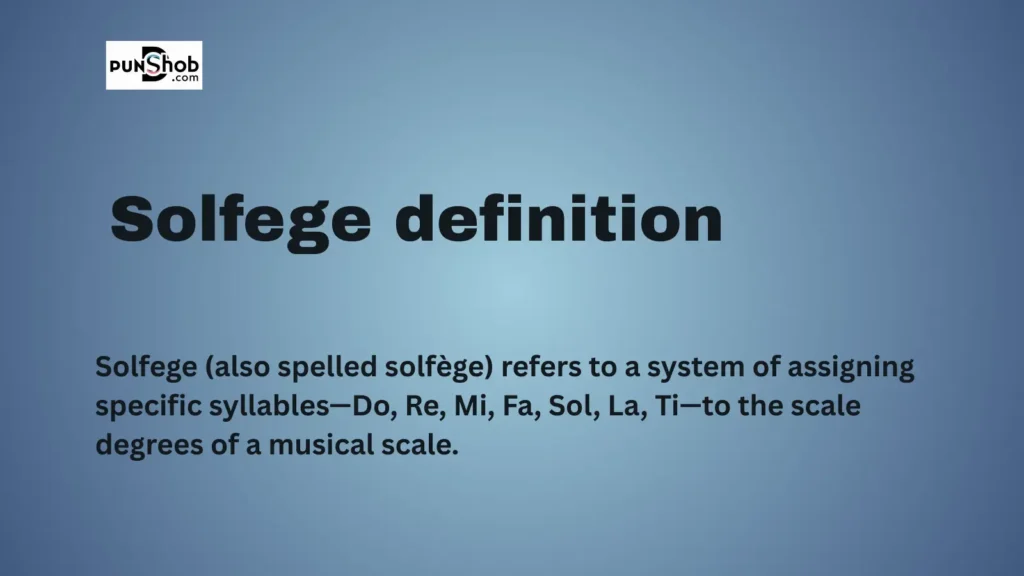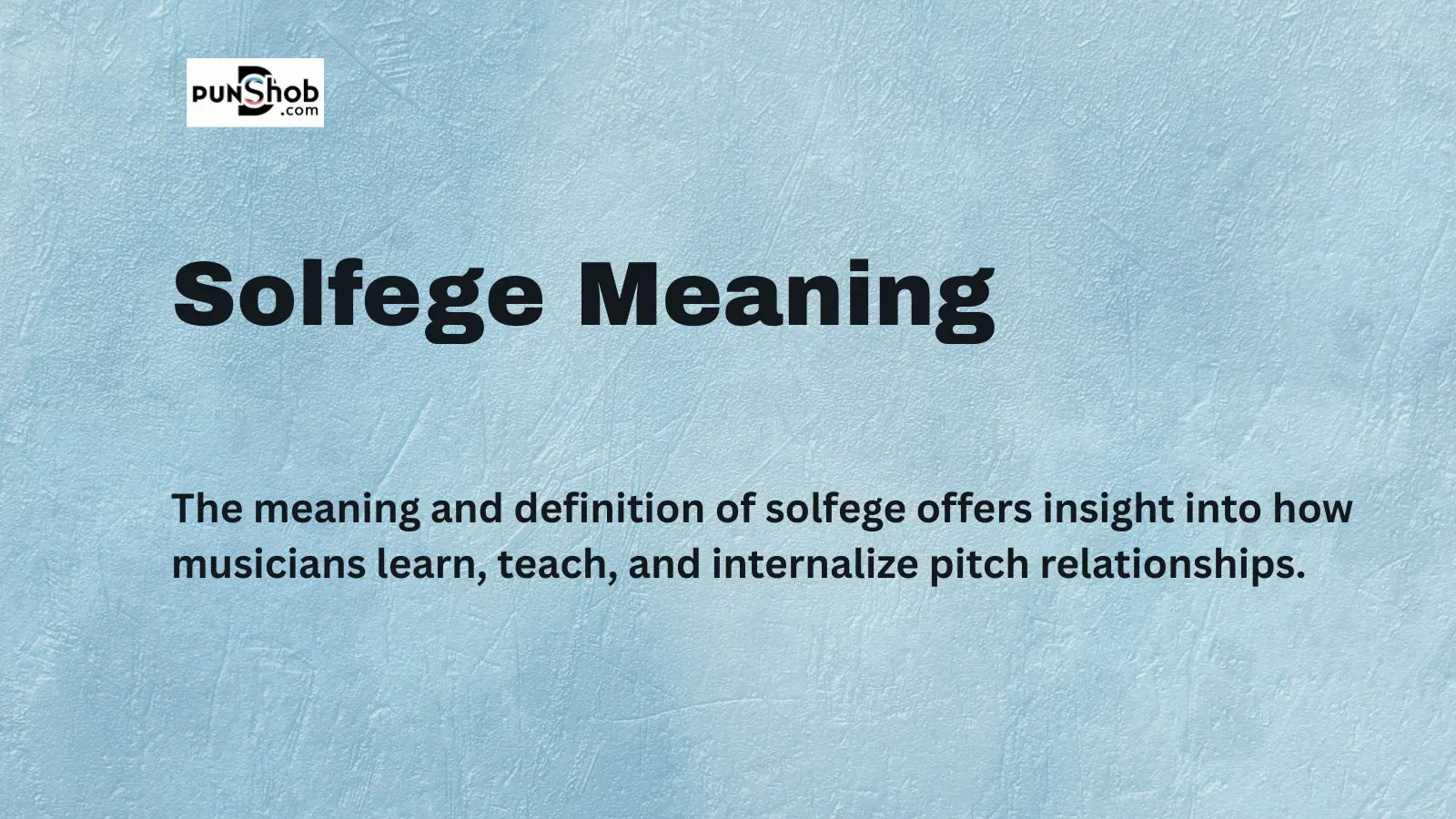Understanding the meaning and definition of solfege offers insight into how musicians learn, teach, and internalize pitch relationships. Whether you’re a vocalist, instrumentalist, educator, or enthusiast, a clear grasp of solfege enhances musical fluency.
What Is Solfege?

Solfege (also spelled solfège) refers to a system of assigning specific syllables—Do, Re, Mi, Fa, Sol, La, Ti—to the scale degrees of a musical scale. It is a pedagogical tool that helps singers and musicians internalize pitch and sight‑sing music accurately.
- At its core, solfege is a method: a way to name notes in a scale and practice intervals.
- It fosters aural skills, helps with sight‑reading, and supports ear training.
- In some traditions, like the movable‑do system, “Do” represents the tonic of whatever key you’re in, while in a fixed‑do system, “Do” always corresponds to the note C.
So the solfege definition is simple: syllables for scale degrees used in ear‑training and sight‑singing pedagogy.
Why Use Solfege?
- Pitch awareness: You hear relationships (e.g. Do–Sol is a perfect fifth).
- Relative tuning: Singing in tune becomes easier when you know the “shape” of the melody.
- Sight‑reading support: You can tackle new music more fluidly.
- Vocal development: Especially helpful for choir singers, classical training, and music education.
Over centuries, methods like Kodály, Curwen, and others have incorporated solfege in structured music teaching.
What Does Solfege Meaning in Text

When you see the phrase “solfege meaning in text”, it typically refers to explaining solfege in written form—that is, how solfege is defined and described in literature, articles, textbooks, or online resources. In such texts, the author is giving a clear meaning of each syllable, how the system works, and the pedagogical aims behind it.
For example:
“In text, solfege meaning is conveyed by defining each syllable’s role: ‘Re’ is the second scale degree, a whole tone above ‘Do’, etc.”
The heading “what does solfege meaning in text” helps readers find that explanatory portion in an article. It signals that a textual description, not just notation or audio, is being offered.
Solfege Meaning – Stand For and Meaning in Text
If you ask “solfege meaning stand for”, you likely want to know what each solfege syllable stands for—i.e. which note and function.
- Do – the tonic (root)
- Re – major second above tonic
- Mi – major third above tonic
- Fa – perfect fourth
- Sol – perfect fifth
- La – major sixth
- Ti – major seventh
- (Do) – octave
In text, this is often written as:
“Do stands for the first scale degree; Re for the second, and so on.”
Educators may add modifiers in minor scales (e.g. “La” for minor sixth when in minor key) or chromatic variants (e.g. “Di” for sharpened Do, “Ri” for sharpened Re, etc.).
When writing an article or educational text, you might see:
“In solfege, Do stands for the root of the key; Re means second scale degree; Mi, third; etc.”
So “meaning in text” implies you’re reading about it, not listening or singing.
Hiatus Meaning in Context of Solfege
Hiatus, in music or text, means a pause, break, or gap. When linked to solfege, a hiatus could refer to:
- A rest or break in vocal training using solfege
- A gap in syllables during vocal exercises
- A pause in a musical phrase where solfege continues after the rest
Example:
In vocal training, a coach may say:
“Take a short hiatus after ‘La’ before hitting ‘Ti’ to feel the transition.”
So, the hiatus meaning in solfege reflects the space between sound and silence, crucial for musical expression.
Why Is Solfege Important?
Solfege does more than help with singing. It builds:
- Pitch accuracy
- Ear training
- Sight-reading ability
- Musical memory
Even professional singers rely on solfege exercises to maintain their vocal precision.
Expressing Well Wishes: Polite, Professional, and Casual Alternatives
This part offers eleven examples of well wishes, tailored by tone and context. Each alternative has subtle nuance—some fit a formal scenario, others casual chat. Use them to adapt your voice depending on the situation:
Eleven Examples of Well‑Wish Expressions
- “Congratulations on your new position!”
Tone: Professional or polite; best in workplace, email or formal card. - “Wishing you all the best in your future endeavors.”
Tone: Formal; appropriate for business transitions or graduation. - “Best of luck with your exam—you’ll do brilliantly!”
Tone: Affectionate but not too casual; for students or colleagues. - “Hope your birthday is as wonderful as you are.”
Tone: Friendly and warm; personal but respectful. - “Enjoy your vacation—relax and recharge!”
Tone: Casual; good for friends or informal colleagues. - “Sending warm wishes for a speedy recovery.”
Tone: Polite and caring; useful in get‑well messages. - “May your new home bring joy and comfort.”
Tone: Thoughtful and courteous; for housewarming contexts. - “Here’s to your continued success—keep shining!”
Tone: Encouraging and cheerful; for close colleagues or mentees. - “Congratulations—what exciting news!”
Tone: Simple but enthusiastic; fits many climates. - “Hope your wedding day is everything you’ve dreamed of.”
Tone: Heartfelt and sincere; personal but respectful. - “Cheers to your anniversary—wishing you many more beautiful years together.”
Tone: Warm and personal; good for friends and family.
Nuances of Tone & Context
- Professional/polite expressions: Use for colleagues, superiors, clients. They reflect respect and restraint (“Congratulations on your new position,” “Wishing you all the best…”).
- Casual/friendly expressions: Use with friends, peers, or informal settings (“Hope your birthday is wonderful,” “Cheers to your anniversary…”).
- Warm/caring expressions: Appropriate when your message involves emotional occasions (illness, weddings, bereavement). These express empathy without over‑familiarity.
Always match your tone to your relationship with the recipient and the occasion. Use more formal language in business or reserved cultures; keep it light and warm with close friends.
Integrating Solfege Concepts with Expression Examples
Although solfege and well‑wishing seem unrelated, the same principles of clarity, tone, and context‑appropriate phrasing apply. Just as solfege syllables differ depending on major/minor scales, well‑wish expressions differ depending on formal/informal situations.
- In major keys (bright tone), solfege syllables like Do‑Re‑Mi may move cheerily upward—this is like expressing enthusiastic wishes, e.g. “Congratulations!”
- In minor keys (more subdued), suitable solfege variants (e.g. La for minor sixth) reflect subtle, caring nuance—similar to “Sending warm wishes for a speedy recovery.”
How to Choose the Best Alternative
- Identify your relationship to the recipient:
- Work/acquaintance → use formal.
- Close friend/family → casual or warm.
- Identify the occasion:
- Achievement/celebration → upbeat, congratulatory.
- Illness or difficult times → sensitive, supportive.
- Consider your tone:
- Keep it respectful if unsure.
- Add warmth if you know the person well.
- Match your phrasing to the medium:
- Emails/cards = polite form.
- Text/social media = casual, shorter.
- Be authentic:
- Choose words that feel natural to you.
- Avoid overuse of clichés unless appropriate.
Eleven Examples Revisited With Context Notes
| Example | Best Used When | Tone Notes |
|---|---|---|
| 1. “Congratulations on your new position!” | Career promotion | Professional, concise |
| 2. “Wishing you all the best in your future endeavors.” | New job or journey | Formal, encouraging |
| 3. “Best of luck with your exam—you’ll do brilliantly!” | Academics or tests | Supportive, friendly |
| 4. “Hope your birthday is as wonderful as you are.” | Birthday wishes | Warm, personal |
| 5. “Enjoy your vacation—relax and recharge!” | Going on holiday | Casual, optimistic |
| 6. “Sending warm wishes for a speedy recovery.” | Illness or surgery | Empathetic, caring |
| 7. “May your new home bring joy and comfort.” | Moving to a new place | Thoughtful, polite |
| 8. “Here’s to your continued success—keep shining!” | Ongoing work/creative effort | Encouraging, upbeat |
| 9. “Congratulations—what exciting news!” | Announcement or surprise news | Enthusiastic, neutral |
| 10. “Hope your wedding day is everything you’ve dreamed of.” | Wedding | Sincere, heartfelt |
| 11. “Cheers to your anniversary—wishing you many more beautiful years together.” | Relationship milestone | Warm, celebratory |
Frequently Asked Questions
What does solfege mean?
Solfege means a system of musical syllables used to teach pitch and sight-singing, such as Do, Re, Mi, and so on.
What is the solfege meaning in music?
In music, solfege refers to assigning syllables to each note of a scale to improve vocal accuracy and ear training.
What is the solfege definition in simple terms?
The definition of solfege is a vocal method that helps singers recognize pitch through syllables like Do, Re, and Mi.
Is solfege used only by singers or also by musicians?
Solfege is used by both singers and instrumentalists to understand musical structure and enhance pitch recognition.
Why is understanding the solfege meaning important in music theory?
Understanding solfege helps build musical memory, improves sight-reading, and is essential for developing relative pitch.
Can beginners easily learn solfege?
Yes, beginners often start with solfege because it’s a structured and intuitive way to learn pitch and melody.
What is a practical definition of solfege for students?
A student-friendly definition of solfege is: a fun and useful way to learn musical notes by singing syllables like Do-Re-Mi.
What is the meaning of solfege?
Solfege is a system of syllables (Do, Re, Mi, etc.) used to represent the scale degrees in a musical scale for ear‑training and sight‑singing. It helps singers and musicians develop pitch accuracy.
How does movable‑do differ from fixed‑do?
In movable‑do, “Do” shifts to the tonic of any key, aiding relative pitch; in fixed‑do, “Do” always refers to the pitch C, like a written note name.
Why learn solfege?
Learning solfege builds a consistent internal sense of pitch, improves sight‑reading, and supports musical memory and improvisation across keys.
4. What is a hiatus in grammar?
A hiatus is a break between two vowel sounds spoken in different syllables, such as in “co‑operate.” It can also mean a temporary pause in activity.
What do white roses symbolize?
White roses symbolize purity, innocence, remembrance, and new beginnings. They’re often used at weddings and memorials.
What well‑wish is best for a work promotion?
For a promotion, a polite and professional choice is: “Congratulations on your new position!” It expresses respect and enthusiasm.
Can I use casual well‑wishes in formal email?
You can, but慎重ly—if you’re unsure, lean on polite phrasing. Casual expressions like “Enjoy your vacation!” may sound too informal in formal correspondence.












Leave a Reply